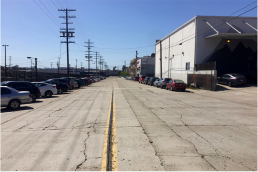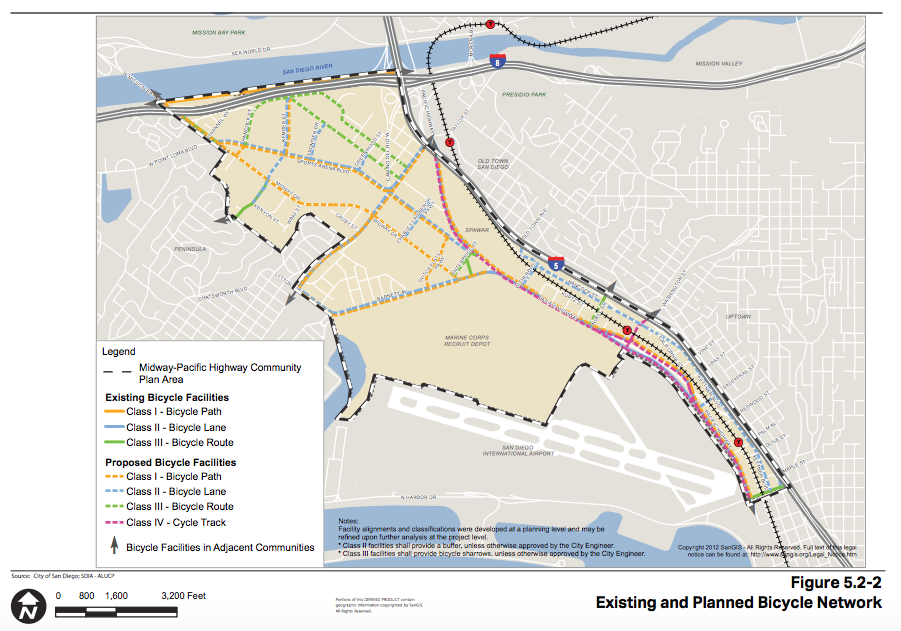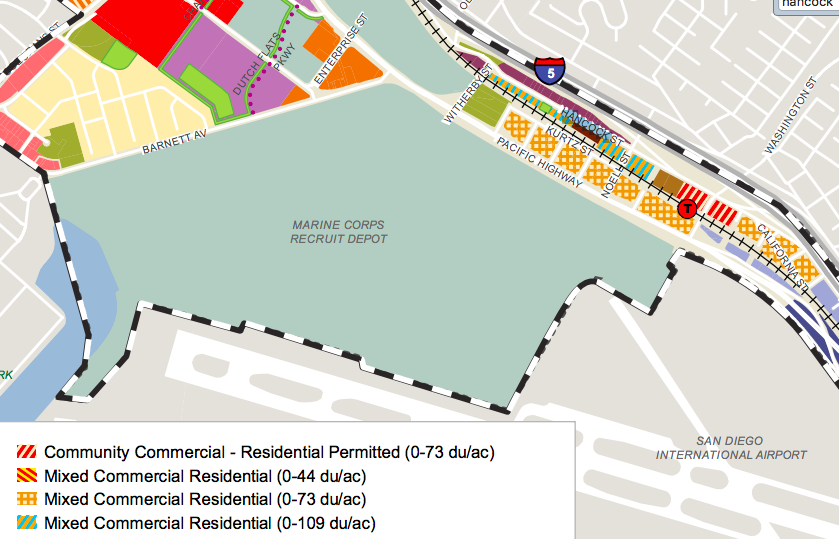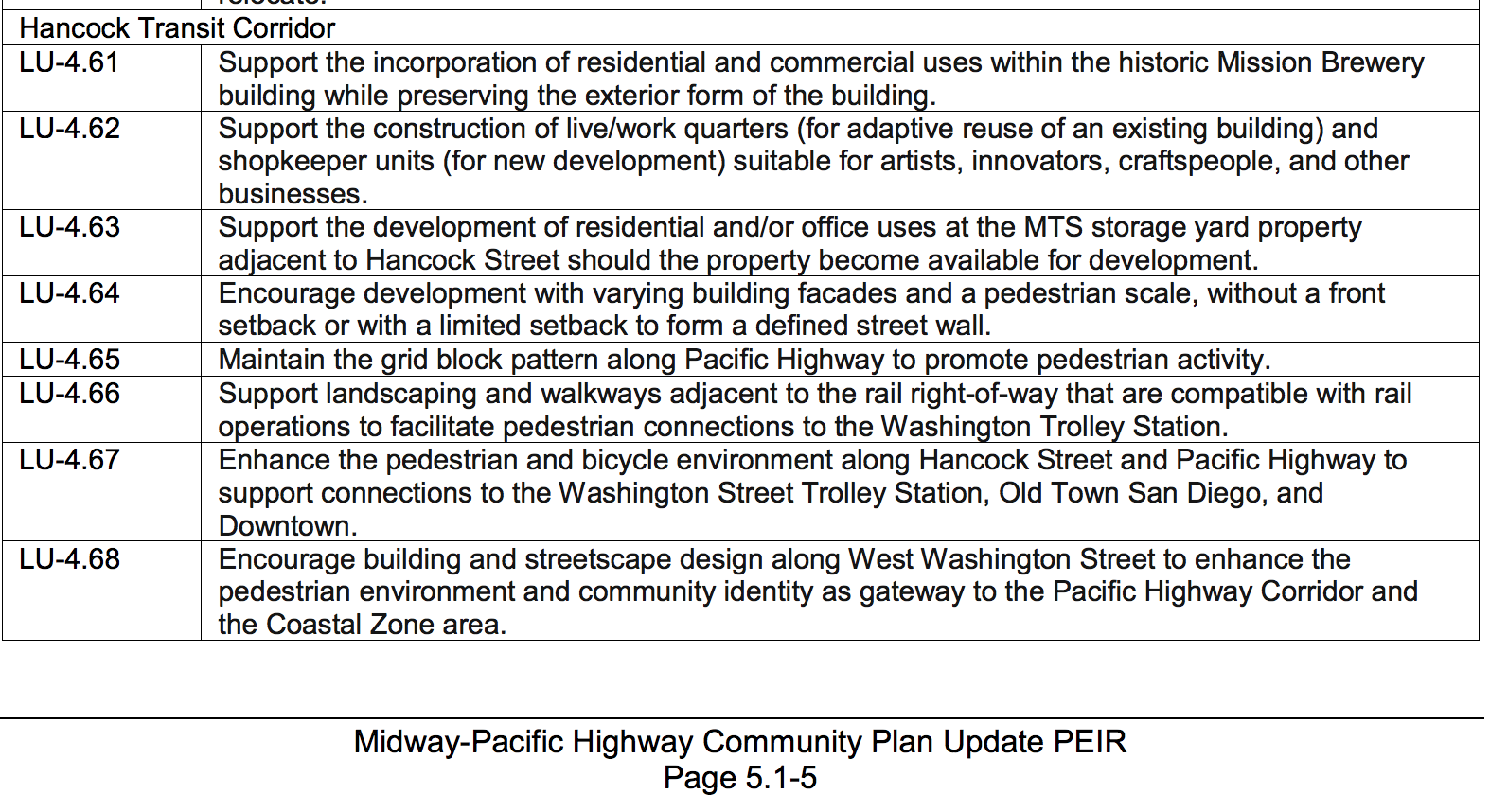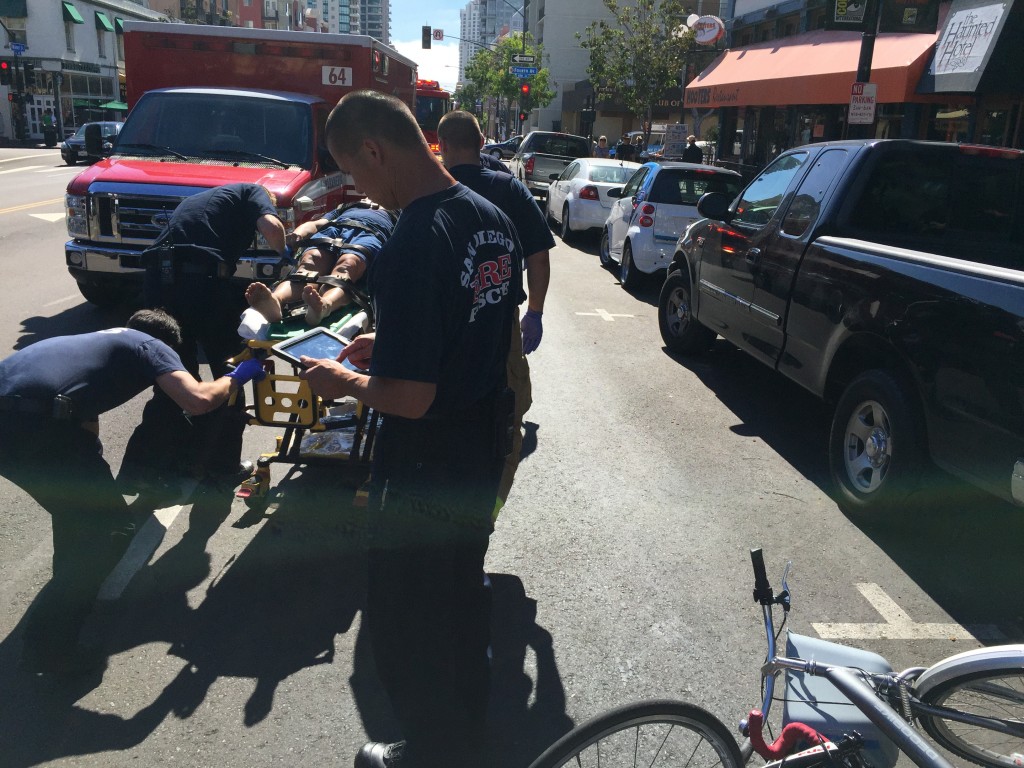Save the Hancock Street Bike Lane
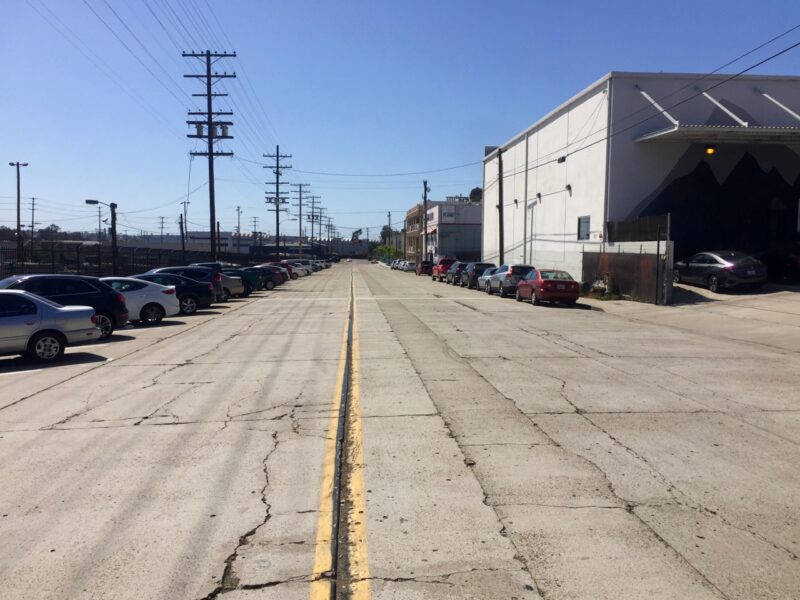
Given the photo above, you might be asking, "Save what bike lane? All I see is another poorly-maintained San Diego street." Well, the City is performing the "Midway-Pacific Highway Community Plan Update" for this area, and this wide, auto-oriented stretch of Hancock Street is set to receive a Class II (unbuffered) bike lane as part of the proposed Hancock Transit Corridor:
Hancock Transit Corridor is envisioned as a multiple-use and mixed-use corridor connected to the Washington Street Trolley Station and the historic Mission Brewery, with a diverse mix of residential, office, and retail uses. Residential development, which can include workforce and affordable housing, will activate the area and take advantage of nearby access to trolley service.
Unfortunately, businesses on Hancock have asked the city to remove the planned bike lane, not because any parking will be removed, but in order to *increase* the existing on-street parking. They are proposing a "Hancock Street Safeway" composed of reverse angle parking on both sides of the street, and sharrows, a bike symbol symbolic of token safety gestures. At this time, we understand the bike lanes have been removed from the Community Plan as it goes to a final City Council vote, as this Planning Department graphic shows
(Update, 06/05/2018 - City staff provided this correction: The City still supports the proposed Class II bike lane, but has been requested by the Smart Growth & Land Use Committee to do further research on whether it would be possible to accommodate both the Class II bike lane and the additional parking desired by the Hancock Street businesses. Planning staff is continuing to look into this with Transportation & Storm Water Department staff. But we still believe that the proposed Class II bike lane best implements the City’s Climate Action Plan goals and best meets the needs of bicyclists in the area.)
More on that below. If you don't have time to read further, we're asking you to please email this letter of support for the bike lane to your district council member. Hundreds of emails in opposition have already been sent to the City.
Some background: this segment of Hancock Street runs through a largely industrial zone wedged between two highways (I-5 and Pacific Highway) and two rail lines (the San Diego Trolley and Amtrak/Coaster). You can see the limited options for pedestrians and bicyclists to traverse this area, despite the nearby Washington Street trolley station (shown below) and Old Town Transit Center:
The Midway Pacific-Highway Community Plan Update is an update to the area's zoning and development plans, and calls for rezoning this area from industrial to very high residential densities, mixed with commercial space:
The Loft2015 apartment building, shown below, is the first example of how this area will be transformed into a mixed-use residential neighborhood adjacent to transit. This means safely accommodating the pedestrians and bicyclists who will be living here, or using nearby transit, or just trying to get through this extremely bike-unfriendly area of San Diego. The Community Plan does propose a cycle track and multi-purpose urban trail along nearby Pacific Highway, but the city has consistently failed to build facilities that require anything more than paint - and the usual lack of funding certainly applies here. Building a cycle track along Pacific Highway would require redesigning high speed on- and off-ramps, and that's extremely costly.
The community plan's "Proposed Policies Related to Land Use", also shown below, explicitly describes why bike lanes are planned for this segment of Hancock: to support connections from housing to nearby transit.
Further, to reduce congestion and parking demand, we need to support travel modes other than just driving.
The Hancock Street Business Association says their Hancock Street Safeway will result in a "safer" Hancock street, and several of the dozens of comments in the community plan preliminary EIR imply that the shared street will be safer for bicyclists than the planned dedicated bike lanes:
Except sharrows aren't safer than dedicated bike lanes. In fact, the presence of sharrows has been shown to make streets more dangerous to bicyclists than no markings at all, since it provides a false sense of security with symbols largely ignored by drivers. During evening rush hour, Hancock becomes a dangerous alternate route to I-5 for aggressive drivers barreling down the street to the next on-ramp. Dodging speeding two-ton vehicles isn't safer for bicyclists than riding in separated bike lanes. And while the street would be narrowed under their Safeway proposal (with cars), this would also occur with bike lanes.
The Hancock Street Business Association has made significant progress in removing the bike lanes from the Community Plan. Several HSBA representatives turned out to the April Midway Community Planning Board Meeting, and that board supported the businesses efforts to "explore opportunities to find more parking". In response to this, City staff reached out to HSBA to discuss options for Traffic Demand Management. Business owners were not willing to consider methods widely used to optimize existing spaces, such as timed parking and/or meters.
Next, a large number of HSBA representatives appeared at an April 26th City Planning Commission meeting and lobbied for more city-subsidized parking. Commissioner James Whalen included a motion for removing the bike lane - after waxing on about his many years of partying at Hancock Street establishment Club Montage (now Spin) and explaining his new "healthier lifestyle":
Apparently Whalen's healthier lifestyle doesn't include biking. The Planning Commission voted to support the HSBA's request to remove the bike lanes from the Community Plan.
Most recently, the City's Smart Growth and Land Use committee (Hancock Street is in committee member Lorie Zapf's district) heard this issue. New BikeSD Executive Director Judi Tentor and board member Nicole Burgess attended the meeting and spoke in support of your riding safety. Partly as a result of these efforts, the Smart Growth and Land Use committee did not support the recommendation for degrading the planned bicycle facility.
Update, 06/05/2018 from City staff: The City still supports the proposed Class II bike lane, but has been requested by the Smart Growth & Land Use Committee to do further research on whether it would be possible to accommodate both the Class II bike lane and the additional parking desired by the Hancock Street businesses. Planning staff is continuing to look into this with Transportation & Storm Water Department staff. But we still believe that the proposed Class II bike lane best implements the City’s Climate Action Plan goals and best meets the needs of bicyclists in the area.
This issue goes to the full City Council on June 26. BikeSD has written a letter in support of the Hancock Street Bikeway - please consider emailing this to your district council member.
Can we talk about parking? Over the past decade, there have probably been at least a dozen cases in San Diego where preserving or adding street parking has neutered badly-needed bike infrastructure. The Hancock Street Business Association responsible for this most recent example is composed of Vertical Hold Climbing Gym, Culture Shock Dance Center, San Diego Circus Center, Cali-Coast Elite Gymnastics, Bikram Yoga College, and Murphy Construction. Vertical Hold has led the HSBA effort for the City to provide them with more free parking, so let's compare the off-street parking they provide versus other climbing gyms in San Diego.
Here's the Vertical Hold Climbing Gym parking lot, which they split with the Circus Center:
It appears to contain approximately one dozen parking spaces. This is the parking lot for Mesa Rim Climbing and Fitness near the intersection of I-8 and SR-163:
I would estimate their parking to be at least ten times that of Vertical Hold, with well over 100 spaces. This is the parking lot for Mesa Rim Climbing and Fitness in Sorrento Mesa:
This lot is at least 5 times as large as Vertical Hold's, with well over 50 spaces.
If these other indoor climbing businesses in San Diego are paying for the parking required for their customers, why is the City of San Diego required to subsidize Vertical Hold with free parking, simply because they provide inadequate off-street parking? It's unfair for bicyclists (many of whom also own vehicles and pay gax taxes) to risk their safety when they pay the same City general fund taxes as drivers that maintain our roads.
Further, the City is attempting to reduce vehicle miles travelled, increase bike and public transit use and improve bike/pedestrian safety. Removing bike lanes to add more free street parking runs counter to these goals. It also sets a terrible precedent for future Community Plan Updates. So we ask the City Council to please restore retain the Hancock Street Class II bike lanes to in the Midway-Pacific Highway Community Plan Update.
UC San Diego's Bike Un-Share
After racking up more than 1000 free rides per day, the new (but unauthorized) Ofo bike share system was removed by UC San Diego officials last month. Despite the obvious demand for bike share, and a four-year-old UCSD undergraduate report describing a bike sharing system for campus, officials pulled the plug on the program.
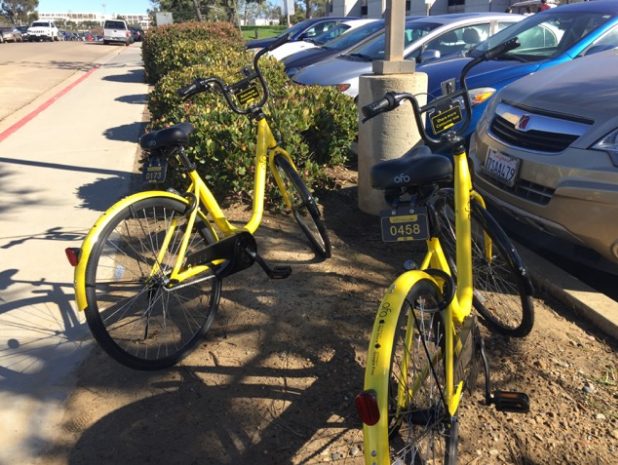
Ofo’s “insurance policies did not meet campus requirements when reviewed by UCSD Risk Services”, according to UCSD Marketing and Communications Director Laura Margoni. In addition, a UCSD police officer explained that no procedure for maintaining or repairing Ofo bikes existed.
Dumping 300 bikes on campus meant Ofo was using the same business model disruption method as Uber, Lyft and Airbnb. Had these sharing economy companies waited for permission from officials - who were often unwilling or unable to comprehend the need for such services - they wouldn’t have succeeded. Similarly, Ofo demonstrated the large demand for bike share at UCSD by bypassing campus rules set by administrators who disregarded years of requests for such a program. After the bikes were removed, UCSD Transportation Services Marketing Manager Curt Lutz said:
“It is my understanding that the impression left by the OFO experience was that there is likely demand for a well implemented bike share program that has a sustainable funding model or to be piloted for trial of competitive models.”
Wasn’t this demand communicated to UCSD by the undergraduate report four years earlier, by multiple students and employees, and in employee parking and sustainability surveys? And while most municipalities have worked out agreements with unauthorized sharing services, UCSD instead removed a bike share system that cost nothing to install, with no official communication about its replacement. (Meanwhile every temporary parking lot closure is announced to campus.) Mr. Lutz again:
“We have been working on a review (internally and with cooperation of SANDAG staff) of bike share vendors, technologies and programs for the past several months to evaluate moving forward with an RFP or RFI (Request for Proposal/Information). UC Riverside and UCLA are just launching programs with two of the prospective vendors offering different technologies. At this time we believe that there is value in monitoring these implementations as part of our process. We are currently working with campus Procurement to scope options for bike share services including business models like OFO.”
Nearly 100 U.S. campuses had bike share systems in 2010, including UC Irvine. UC Berkeley will implement Bay Area Bike Share shortly - without monitoring UCLA and UCR. Yet UCSD still needs to monitor these programs before issuing a Request for Information? Encouragingly, Margoni states that a bike share pilot will roll out at UCSD this fall.
A bike share program is important to UC San Diego for a number of reasons. The freeway-like roads (or stroads) surrounding campus make conditions too dangerous for many off-campus residents to commute by bike:
- Genesee Avenue on the north side of campus is 6+ lanes of 60 MPH+ traffic just inches from riders (here’s audio of a KPBS reporter attempting to bike it).
- The $105 million dollar Genesee Ave bridge being built over I-5 will be 10 car lanes wide, yet there wasn’t enough room for a protected bike lane.
- La Jolla Village Drive is also 6+ lanes of 50 MPH+ traffic, with pedestrians being hit and killed on its curving, high-speed I-5 on-ramps.
- Gilman Drive is 4+ lanes of 60 MPH+ traffic, with aggressive drivers often veering into the bike lane to cut into the I-5 south onramp queue.
As a result of the above, many commuters use SDMTS bus routes that take them to the Gilman Transit Center, on the south side of campus. This a 15-30 minute walk to many buildings on the vast UCSD campus, and bike share would address this first/last-mile problem of public transit. UCSD does offer a useful shuttle system, but if you miss one it’s still faster to walk.
Some students do use the limited bike racks (two) on MTS buses, but they are vulnerable to the massive bike theft problem on campus. Bike lockers would offer increased security but these do not exist at UCSD, despite my requests for installation several years ago.
While biking could shorten the long walk times between buildings, it is actually against the rules to ride a bike on either of the main north-south campus routes, from 8:30 AM to 5 PM. As a result, students frequently receive costly tickets simply for biking to class. As this report from CirculateSD suggests, why not simply create dedicated bike lanes on these routes and elsewhere on campus? BikeSD covered San Diego State’s new bike lanes back in 2011:
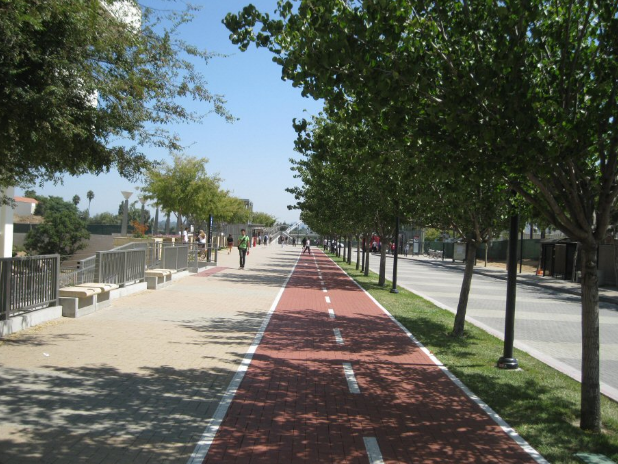
Instead, the Grove Path bike lane was installed for a short segment between the two main north-south UCSD pedestrian-only routes. Pedestrians often use the bike-only Grove Path lane, and are not cited for doing so.
Since bike share helps solve the last-mile problem of public transit, UCSD’s removal of Ofo contradicts the university’s attempts to increase the number of commuters using alternative transportation to campus. Proclaiming “Sustainability is in our DNA”, UCSD’s 2008 Climate Action Plan seeks to decrease the number of solo-driver commuters from 49% to 39% by 2018, via increased biking, walking, and public transit usage. Transportation is the largest contributor to greenhouse gas emissions in California, and San Diego faces severe coastal impacts from a predicted 10-foot sea level rise by the end of the century:
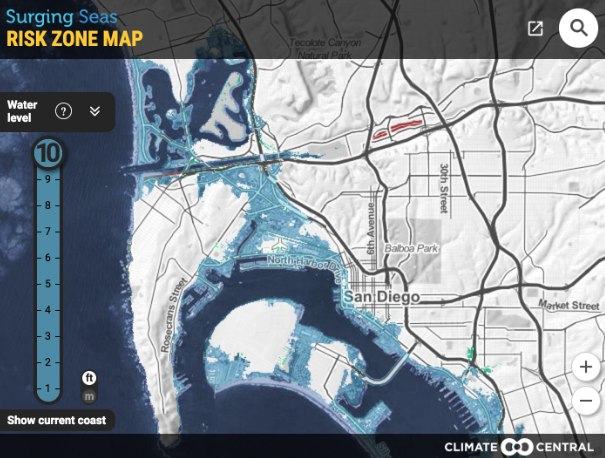
However, since its Climate Action Plan was announced, UC San Diego has taken the following actions with respect to transit:
- Terminated its free bus zone program for students and employees (employees can receive an EcoPass discount)
- Removed a free bike share program
- Endangered bicyclists on Expedition Way and Voight Drive, by adding street parking to these narrow, hilly roads
- Supported the $6.5 billion dollar widening of I-5 in North County - which includes no bus routes servicing campus
- Announced the construction of three new parking garages on campus, despite the Mid-Coast Trolley’s arrival in 2021
UCSD’s goal of reducing single occupancy commuters is shared by the UC Office of the President (UCOP), which publishes an annual report outlining mode share rates and reduction goals:
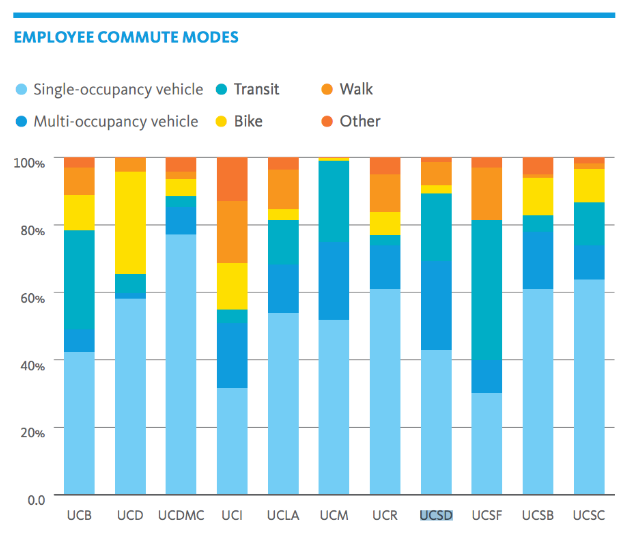
However, UCSD’s mode share numbers above are for all commuters entering campus, including students - not employees, as the report indicates. Since the university has no way to distinguish students from employees in its semi-annual counts, the employee single occupancy vehicle number shown above is incorrect (a commuter mode share survey was recently launched to address this misrepresentation), and skewed downward by the large number of students using public transit. Students voted overwhelmingly to pay a quarterly fee for discounted bus service after the free bus zone was killed, and the MTS 201/202 Super Loop has the highest ridership per revenue hour in San Diego’s bus system.
It should be noted that UCSD has taken some positive steps regarding alternative transportation, including the well-intentioned Grove Path above, and planning for Class II (unprotected) bike lanes on a short segment of Gilman Drive and the new Voight and Gilman bridges. UCSD is contributing at least $1.2 million to the Gilman Drive bridge, which will provider a calmer east-side route to campus. UCSD also provided 1.6% of the funding for the Genesee/I-5 project, which will include a bike path connecting campus to the Sorrento Valley Amtrak station. Yet many of the projects identified in the 2012 Bicycle and Pedestrian Master Planning Study still have not begun, nor has funding been identified.
Further, UCSD’s alternative transportation spending is constrained by its limited sources, which are parking and ticket revenue. (UCOP goals for increasing alternative transit usage aren’t backed by significant funding.) And employee parking permit fees don’t come close to paying for the $100 million-plus cost of multiple new parking garages planned for campus (Torrey Pines North Living/Learning Neighborhood, Mesa Nuevos and Osler). Given the rapid rise of ride-sharing services like Uber/Lyft, does it make sense for the university to continue building costly parking garages? As ride share systems test flat-fee pool programs, new and inexpensive options will exist for automobile commuters to skip vehicle storage on campus.
If sustainability is truly in UC San Diego’s DNA, it should be leading state efforts to reduce greenhouse gas emissions from transportation. Removing a free bike share system that complements public transit isn’t leadership, nor is it consistent with UCSD’s sustainability claims.
Power to the People (on Bikes)
Trying to make San Diego’s roads safer for people on bikes can seem daunting. Who has the time to attend every public event where changes to your neighborhood’s streets are being considered? From city and SANDAG meetings that take place while we’re all at work, to community planning meetings and bikeway open houses that occur on busy weeknights, it’s nearly impossible to consistently make your voice heard.
Meanwhile, there are powerful forces in our communities actively working against your safety and the taxes you pay for it. In Hillcrest, three years of public input on the SANDAG Uptown Bikeway was disregarded when the Hillcrest Business Association successfully lobbied SANDAG and the city to eliminate most of the project from University Avenue. Remember, this project is paid for with your TransNet sales tax dollars. Yet the HBA was able to raise tens of thousands of dollars using funds from the Hillcrest Farmers Market and business donations, and this money is still being used to kill the rest of the Bikeway. So even when your voice is heard, it’s being drowned out by powerful, politically-connected interests that put street parking over your health, safety and tax dollars.
For me, the best way to make sure my voice actually has an impact is to support BikeSD. That’s because BikeSD’s executive director, Sam Ollinger, is the best resource we have in San Diego to create positive change. I’ve seen Sam speak numerous times at public meetings and there is no one more knowledgeable and effective at making our case than her - period. And when our safety is on the line, she doesn’t accept weak compromises like other advocacy organizations in our city. But after years of donating her time for free to our cause, we need to be able to fund her efforts. And that’s why I’m asking you - in the midst of paying your holiday credit card bills - to please give what you can so Sam can continue to represent us in making our streets safer.
Fortunately Sam isn’t alone in her efforts. She leads a team of volunteer members like myself, who also participate in public meetings and advocate on your behalf. Your voice is made much stronger by our collective efforts. For example, political candidates seek BikeSD’s endorsement for their campaigns. We see through the rhetoric of elected officials who urge residents to bike more for the environment, then cave in to parking lobbyists. And BikeSD is a non-profit organization, so every dollar you donate goes toward our advocacy efforts.
Finally, for years I’ve read about people on bikes being seriously injured in our city, but in 2015 I was personally impacted. While riding downtown on our city’s bike share system (which operates on mostly unsafe streets), my husband was car-doored. He suffered a severe concussion and spent two nights in the hospital; he still hasn’t fully regained his sense of smell six months after the accident.
Seeing someone I love laying unconscious in the street was shocking, and watching him suffer in a hospital bed only strengthened my resolve to fight. What if you or someone you love is injured as a result of our city’s failed leadership for safer streets? I’m asking you to take a stand to help ensure your safety and others who bike. Your donation to BikeSD can help make a difference for all of us.
Uptown Bike Corridor: A Critical Juncture for Our City's Future
If you are a business owner that supports our mission and wants to see our city become a world class city for bicycling, please help us by taking this survey. It will help us evaluate any concerns you have so that we can consider them in our advocacy. Thank you.
---
In my previous post for Bike SD, I described the Interim Height Ordinance in Uptown and its use by community planners to promote lower densities and increased parking. This time I’ll be talking about the SANDAG Uptown Bike Corridor Project that would create protected bike lanes (cycle tracks) for both local residents and bicycle commuters.
On Thursday, February 6th there’s a community update on the Uptown Bike Corridor at Roosevelt Middle School (3366 Park Blvd), and final routes will likely be presented based on prior feedback.
The meeting is also an opportunity for local businesses to give their input. Bike SD has created a Bike Friendly Business Survey to understand their concerns and goals regarding safe bike lanes in San Diego.
The Uptown Bike Corridor is part of SANDAG’s San Diego Regional Bike Plan, a “network of corridors enabling residents to bike safely on more direct and convenient routes between major regional destinations”. It’s part of the San Diego Regional Comprehensive Plan, which provides “a balanced regional transportation system that supports smart growth and a more sustainable region.” Our elected leaders on SANDAG’s board unanimously support the Bike Plan, and directed over $200 million in Early Action funds to the project last year.
My last post suggested that the Uptown Planners Community Planning Group, who advises the city regarding land use and development projects, is out of touch with (or actively opposed to) current urban neighborhood trends. Its position on the Uptown Bike Corridor is no exception. During a meeting last year, a majority of the packed room spoke in support of cycle tracks on University (or Washington) Avenue, and 4th/5th Avenues. Uptown Planners responded by voting not to consider the project until the completion of its community plan in late 2015. Meanwhile construction of the Corridor is set to begin in 2016.
Funding doesn’t guarantee the Uptown Bike Corridor will be built. It faces strong opposition from Uptown Planners and some residents. At last year’s meeting, an Uptown board member said, “This is San Diego. We drive here. If you want to ride a bike, go to New York City.” While a majority of the board’s members likely make all their trips by car, this is not the trend among Americans between the ages of 16 and 35. For them, car travel is down by 23% while bicycle trips are up by 24%.
A report by the U.S. Public Interest Research Group states “(Younger Americans) are more likely to consider forms of transportation beyond the car – the go-to option for many older Americans”. Another report says millennials are “less likely to personally own a car or drive one regularly”, and “(cite the) environment as a motivation behind their transportation choices/routines”. This last reason is consistent with the sustainability part of the SANDAG Regional Comprehensive Plan. Conversely, here’s the view of an Uptown activist opposed to moving forward:
Uptown Activist, "Addressing climate change and minimizing automobile reliance...Hillcrest is(n't) the best place for that focus."
— Great Streets SD (@GreatStreetsSD) January 6, 2014
San Diego is losing millennials at a rate higher than nearly any other major U.S. city. Even the “hip” Hillcrest zip code of 92103 saw a two percent drop in persons aged 20-44 from 2000 to 2010. Could one reason be that our city has lagged its peers in implementing robust public transit and cycling infrastructure? The top cities millennials are moving to include Portland, Seattle, San Francisco, Denver, Minneapolis, D.C., and Austin, which are all on this list of “best cycling cities in America”. It’s urgent that San Diego and its current hourglass economy comprised of few middle-income workers attract a talented pool of younger residents to work in the highly-skilled industries driving our city’s economy. If the San Diego Regional Economic Development Corporation really wants to compete in the global market place and remain relevant in the coming months and years, the leadership at the EDC needs to start taking a serious look at our woefully inadequate bicycle infrastructure. Our talent is flocking to other cities and we're losing out.
Safe bike infrastructure isn’t just about millennials’ preferences - bicyclists of all ages are rightfully scared to venture onto our unsafe roads. Those opposed to safe bike lanes claim there aren’t enough riders to justify building them, yet the Green Lane Project describes 8 cases around the U.S. where installing protected bike lanes increased ridership from 54% to 266%. Last year’s CicloSDias event in San Diego saw thousands of riders take part, many of them families enjoying streets closed to auto traffic.
Opposition isn’t limited to Uptown Planners. The publisher of the Presidio Sentinel in Mission Hills has personally lobbied SANDAG against the Bike Corridor, and looks upon cycling as a lifestyle choice:
Just because we build a bike corridor, that doesn’t mean people will ride bikes. It’s about lifestyle. You choose to be a bicyclist.
Was teenager Angel Bojorquez, an Albertsons cashier working past the end of daily bus service, choosing to be a bicyclist when he was killed in a hit-and-run while riding a dangerous Rancho Santa Fe road?
It’s difficult to break the prevailing mindset in Southern California that roads are for cars only. A recent LA Times editorial stated:
The very design of the city has supported and emphasized the idea that the roads belong to them and that anybody not using a car is an interloper at best and a threat (to their rights, freedom of movement, even happiness) at worst. This familiar attitude suggests that every change to the city, whether it's new architecture or new transit lines, should be weighed primarily, if not exclusively, by its impact on motorists and levels of car traffic. It has seeped so deeply into the civic consciousness that it has fundamentally skewed debate on a wide range of crucial issues.
Drivers only pay 51% of road costs, and most cyclists and pedestrians are drivers too. Don’t they also deserve safe access to our roads?
Increased auto congestion is another justification against bike lanes, but isn’t this an inevitable by-product of vibrant, successful cities? The Uptown Bike Corridor will implement bike lanes on just a handful of the dozens of lanes devoted exclusively to parking and vehicle travel in Uptown.
Loss of street parking is the most common objection to the project. Yet on Park Boulevard, there will be a net gain of parking spaces for the Mid-City Rapid Bus Line by implementing angled parking on side streets. Can’t we do the same for the Bike Corridor? Increased meter rates/hours would also result in more parking turnover. And Hillcrest has implemented a business corridor shuttle with service to the free DMV parking lot.
Removing parking spaces or travel lanes for protected bike lanes has actually increased local business in several cases, including New York City, Fort Worth, Memphis, Long Beach, and Seattle (Uptown Planners ignored these examples when cited last year). In 2010, El Indio owner and Uptown Planner Jennifer Pesqueira vowed not to give up a single street parking space for the benefit of cyclist safety. It’s hard to find compromise with that.
Bike share is coming to San Diego in the next few months, adding hundreds to thousands of cycling trips per day to our roads. Are we going to put these riders, many of them visitors unfamiliar with our city, on unsafe streets forever?
Pedestrians benefit from bike lanes too, through road calming, removal of cyclists from sidewalks, and creation of pedestrian islands that shorten street crossing distances even more than bulb-outs used elsewhere in Uptown:
The obstacles bicyclists face in securing safe bike lanes for Uptown aren’t unique to San Diego. In Chicago, a woman summed up opposition to a proposed protected bike lane when she said, “I like the neighborhood the way it is". It isn’t just that improving safety for Chicago cyclists might inconvenience her, but because it requires change. And to many in Uptown, that’s simply unacceptable.
The truth is that neighborhoods do change over time, for better or worse. Uptown’s planners have placed residents’ parochial concerns over consensus-based regional transportation solutions, and they continue to apply yesterday’s auto-centric planning to the community’s future. If you want to change Uptown for the better, voice your support for safe bike lanes next Thursday.
Height Restrictions and Bicycles: Uptown is at a Transportation Crossroads
What is the Interim Height Ordinance, and what does it have to do with bicycles?
Currently, the Interim Height Ordinance (IHO) limits building heights in Hillcrest and Mission Hills to 65 and 50 feet, respectively. Prior to the IHO, the 1998 Uptown Community Plan allowed building heights up to 200 feet on some streets, and under these guidelines a 12-story hotel was proposed for 301 University Avenue in 2008. The project was out of scale for the relatively narrow street, so residents protested, and the City Council enacted the IHO for the two years required to complete Uptown’s Community Plan.
That was then. Now, over five years later, the Community Plan is targeted for completion in late 2015. Meanwhile the IHO has been extended repeatedly. Many residents and community leaders advocate for making it permanent, or even further reducing its height limit.
Why should Bike SD’s readers care about Uptown building heights? Because the Uptown Planners (the community planning group for Hillcrest, Bankers Hill, Mission Hills and University Heights) advises the city on both this issue and the proposed SANDAG Uptown Bike Corridor. Many of the board and community members who oppose smart growth in Uptown also oppose implementing safe bike lanes. Last year, Uptown Planners voted against even considering bike corridor implementation in their neighborhoods until the community plan was completed. In my next post, I’ll discuss the bike corridor in greater detail, and whether increased density can make neighborhoods more bike-friendly.
Since the IHO went into effect, the trend of millennials and empty-nesters moving to urban neighborhoods from suburbs has increased. Good resources on the subject include recent books The End of the Suburbs, Walkable City, and The Great Inversion and the Future of the American City. These new residents seek walkable, bikeable, active communities with various transit options to nearby downtown jobs. “Smart growth” and “transit-oriented development” are two terms describing the mixed-use construction built to accommodate them. There are numerous benefits to this trend, from reduced vehicle miles driven to increased public transit use, even increased innovation and reduced obesity rates. In San Diego, with projections of a large population increase in Council District 3, Hillcrest represents an ideal location for smart growth - without putting all new growth downtown, as some suggest.
Instead of addressing this demand, the IHO has arguably suppressed residential construction in Hillcrest. IHO supporters cited the Snooze AM building on 5th Avenue as an example of IHO-era construction, but it contains zero residential units. While there are many excellent examples of urban neighborhoods with human-scale architectures of 5 stories, commercial thoroughfares like eastern University Avenue, Park Boulevard, and 4th/5th/6th Avenues all present opportunities to carefully exceed this height without ruining the neighborhood’s character. To be fair, construction costs do increase significantly above 65 feet, and raising the height limit won’t magically produce affordable and middle class housing - but it would likely offer an improvement over the current lack of construction.
What are some reasonable alternatives to making the IHO permanent that permit mixed-use projects on main streets while retaining neighborhood character? One plan floated by city planning staff set 45-65 foot height limits for Mission Hills and Hillcrest, with discretionary review required above that level. Heights could surpass 100 feet if community amenities were provided, such as parks or plazas. Another plan offered by Walt Chambers on his Great Streets San Diego site considers commercial street widths. At a recent Uptown Planners meeting where Chambers’ plan was presented, the Uptown Community Planning Group Chair, Leo Wilson, acknowledged that height/discretionary limits between 65 and 100 feet might be a workable compromise.
Unfortunately, many community members are unwilling to budge from the IHO. Chief among their complaints are: congestion and lack of parking. However these problems are present in almost any urban neighborhood around the country.
Nearly all of San Diego was built for cars, often at the expense of pedestrians and bicycle riders. However I think Hillcrest is great precisely because it is different in this regard. The Hillcrest community owes its strengths of being more walkable with diverse amenities largely to its higher density (relative to the rest of the city). Furthermore, many potential new residents to Uptown have little desire to own a car and seek alternative transit options. So why do Uptown's leaders continue to insist on applying suburban planning principles to their community?
A diversity of incomes in Uptown could reduce congestion, since some lower-income workers would live near their jobs rather than driving in and parking. Instead, Hillcrest’s anti-growth stance is morphing it into a neighborhood that is exclusive only to individuals who occupy a higher income bracket. This is troubling, since the Uptown neighborhood used to welcome anyone - especially gays and lesbians who experienced discrimination. Now many of these same community members who used to be discriminated against are unwittingly discriminating against middle and lower-income earners, as they close the door to new residents due to their shortsighted stance on height limits and downzoning.
IHO proponents frequently state that the “good businesses will survive” without new growth, but doesn’t this aversion to increasing the height limit limit the total number of good businesses? Instead of a virtuous urban cycle of more residents attracting more businesses attracting more residents that we’ve witnessed in North Park and Little Italy, Hillcrest’s businesses struggle and the neighborhood’s vibrancy wanes.
Some residents have described a fear that outside developers would tear down historic architecture, but as a member of Save our Heritage Organisation, I support strengthening the city’s historic preservation laws in order to prevent this.
Bicycle riders will benefit from awareness of the challenges they face in implementing bike infrastructure in Uptown. The majority of the Uptown Planners’ board members, and the residents who attend its meetings, have demonstrated that they are either woefully out of touch or simply opposed to the interests of tomorrow’s Uptown residents. It’s important that we all participate in planning Uptown’s future, whether the issue is building heights or cycle tracks.
---
You can read more from Paul Jamason at SD Urban

